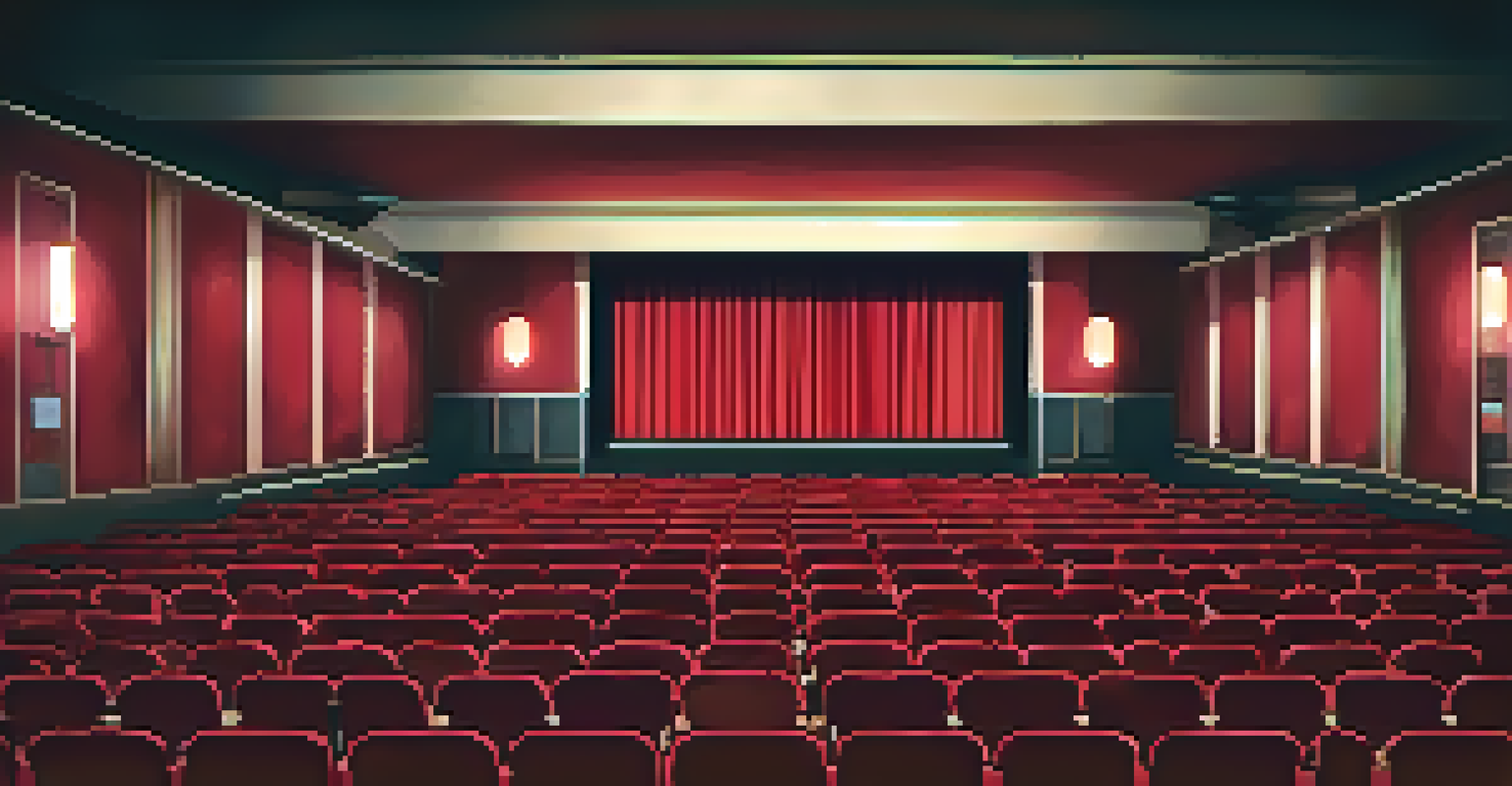Using Silence Effectively: The Power of Quiet in Film Scores

Understanding the Role of Silence in Film Scores
Silence in film scores might seem counterintuitive, but it plays a crucial role in storytelling. It acts as a canvas upon which the emotional weight of a scene can be painted. Just like a painter uses empty space to draw focus to certain elements, filmmakers rely on silence to emphasize pivotal moments.
Silence is a source of great strength.
When the music fades, it allows the audience to absorb the gravity of a scene or the nuances of a character's expression. Think about those moments in films where a character experiences a profound realization or loss; the absence of sound can heighten the emotional impact. This intentional use of quiet can transform a simple scene into a powerful, memorable experience.
Moreover, silence can create suspense, allowing viewers to feel the tension building in a scene. It acts as a pause, giving the audience a moment to anticipate what's next. This powerful tool, when used effectively, can make the subsequent music or sound all the more impactful.
Historical Examples of Silence in Film Scores
Many classic films have masterfully employed silence to enhance their narratives. Alfred Hitchcock's 'Psycho' is a prime example, where the infamous shower scene is punctuated by a sudden absence of sound before the iconic score kicks in. This silence amplifies the shock and horror, leaving a lasting impression on viewers.

Another notable example is 'A Quiet Place', where the very premise hinges on the absence of sound. The film's score often fades into silence, making the audience acutely aware of every little noise. This not only builds suspense but also immerses the viewer in the characters' world, where silence is a matter of survival.
Silence Enhances Emotional Impact
Silence in film scores acts as a powerful tool to elevate emotional moments, allowing audiences to connect deeply with characters and their experiences.
These historical instances underscore that silence isn’t just a lack of sound; it’s a deliberate choice that can lead to profound emotional responses. By looking back at these examples, we can appreciate how silence has shaped the way we experience film.
The Psychological Impact of Silence on Audiences
Silence can evoke a wide range of emotions, often tapping into our subconscious. When music fades away, it creates a sense of vulnerability, allowing the audience to connect deeply with the characters' emotions. This connection can make the viewing experience more personal and intense.
In the end, we will remember not the words of our enemies, but the silence of our friends.
Psychologically, silence can be unsettling, triggering feelings of anticipation or anxiety. Just think of a thriller where silence precedes a critical moment; it keeps viewers on the edge of their seats, making them more invested in the outcome. This emotional engagement is what makes film scores so powerful.
Additionally, silence gives space for reflection, allowing audiences to process what they’ve just witnessed. As the credits roll, it’s often those quiet moments that linger in our minds, prompting us to think about the film long after it has ended.
Using Silence to Create Character Depth
Silence can reveal a lot about a character’s internal struggles without uttering a single word. For instance, a character sitting in silence can convey feelings of isolation or contemplation. These moments can be incredibly powerful, as they invite the audience to empathize with the character’s experience.
Consider a scene where a character is dealing with grief; a prolonged silence can speak volumes about their emotional state. This subtlety allows filmmakers to explore complex themes that might be lost in dialogue or action. The absence of sound can be more revealing than any spoken line.
Historical Use of Silence in Film
Classic films like 'Psycho' and 'A Quiet Place' showcase how silence can amplify tension and narrative depth, illustrating its intentional use in storytelling.
Moreover, silence can be used to contrast a character's turmoil with the chaos around them. This juxtaposition can highlight their inner conflict, providing deeper insights into their motivations and struggles. In this way, silence becomes a vital tool for character development.
Building Suspense and Tension with Silence
Silence is a masterful tool for building suspense in film scores. A well-placed pause can heighten tension, making the audience hold their breath in anticipation. This technique is often used in horror films to create an unsettling atmosphere, where every creak and whisper is amplified by the quiet.
When filmmakers strategically use silence before a climactic moment, it not only raises the stakes but also makes the payoff more satisfying. Think of the suspenseful moments in films like 'Jaws', where the absence of music before a shark attack keeps viewers on edge. This builds a connection between the audience and the narrative, drawing them deeper into the story.
As viewers, we become attuned to the rhythm of silence and sound, learning to anticipate what might happen next. This anticipation makes the eventual sound or score hit much harder, intensifying our emotional response to the film.
Silence as a Contrast to Music: Creating Impact
Silence can serve as a stark contrast to the music in film scores, making the moments of sound feel more impactful. When music swells after a period of silence, it can evoke a stronger emotional reaction from the audience. This contrast is often used to signify a turning point or a significant emotional release in the story.
For example, in 'Interstellar', composer Hans Zimmer uses quiet moments to allow the weight of the narrative to sink in. When the score finally swells, it feels like a cathartic release, pulling viewers along on an emotional journey. This technique shows how silence can enhance the overall impact of the film.
Silence Builds Suspense and Tension
Strategically placed silence creates anticipation and heightens suspense, making the eventual sound or score more impactful for the audience.
By understanding this dynamic, filmmakers can craft a more engaging and immersive experience. The interplay between silence and music creates a rhythm that guides the audience's emotional journey, making it a critical element in film scoring.
Practical Tips for Using Silence in Film Scoring
For aspiring composers, incorporating silence into film scores starts with understanding the narrative. Identify key moments where silence can enhance emotional depth or tension. This requires careful observation and a willingness to experiment, as silence can be just as expressive as music.
Consider creating a sound map for your film, outlining where silence can be strategically placed. This allows you to visualize the emotional ebb and flow of the score. By doing so, you can pinpoint opportunities where silence can amplify the impact of your music.

Lastly, don’t be afraid to trust the power of silence. It may feel uncomfortable at first, but often, the absence of sound can lead to the most profound moments in film. Embrace the quiet, and let it guide your audience’s emotional experience.